QUESTIONS
SECTION A (40 marks)
Answer all the questions in this section in the spaces provided.
-
- Define the term "power".(1 mark)
- Define the job descriptions of the following careers open to a power mechanics graduate after further training.(3 marks)
- Automotive mechanic
- Power plant mechanic
- Automotive parts dealer
-
- State the most appropriate type of fire extinguisher for putting out the fires caused by the following:(2 marks)
- Electrical short circuits
- Firewood
- Flammable liquids
- Combustible materials
- Name four thread series commonly used in engineering.(2 marks)
- State the most appropriate type of fire extinguisher for putting out the fires caused by the following:(2 marks)
-
- Figure 1 shows a micrometer setting. If the accuracy of the micrometer is 0.01 mm, determine the reading of the micrometer.(2 marks)
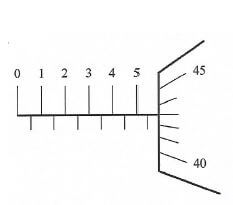
Figure 1 - State two areas where each of the following fasteners is used in motor vehicle.(2 marks)
- Splines
- Keys
- Figure 1 shows a micrometer setting. If the accuracy of the micrometer is 0.01 mm, determine the reading of the micrometer.(2 marks)
-
- Outline the procedure of cutting an internal opening on a piece of metal using a chisel.(2 marks)
- Differentiate between the energy conversion in a Starter Motor and a D.C. Generator.(2 marks)
-
- List four parts of the jet propulsion engine.(2 marks)
- State the functions of the following components of the ignition system:(2 marks)
- Condenser
- Spark plug
-
- State two methods of driving the camshaft in a single cylinder engine.(2 marks)
- Name the components driven by the following parts of a camshaft of a multi-cylinder engine.(2 marks)
- Spiral gear
- Eccentric cam
-
- State the operational difference between a thermosyphon and a pressurised cooling system.(2 marks)
- State two functions of the gearbox. (2 marks)
-
- State the purpose of each of the following head lamp units:
- Reflector
- Lens
- State three materials used to make cach of the following:(3 marks)
- Soft solders
- Hard solders
- State the purpose of each of the following head lamp units:
-
- Name four parts of air brake system.(2 marks)
- State two methods of attaching the wheel hubs to the axle shafts. (1 mark)
-
- Give two possible causes of a vehicle swaying when taking a turn.(2 marks)
- Explain each of the following terms as used in a steering system: (2 marks)
- Kingpin inclination
- Included angle
SECTION B (60 marks)
Answer question Il on the A3 paper and any other three questions from this section in the spaces provided. Candidates are advised to spend not more than 25 minutes on question 11.
- Figure 2 shows three orthographic views of a casting for a stand drawn in first angle projection.
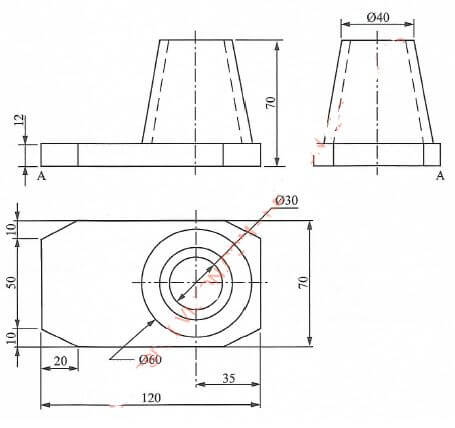
Figure 2
On the A3 paper provided, draw the casting Full Size in isometric projection taking A as the lowest point.(15 marks) - With the aid of a labelled diagram, explain the operation of a two stroke diesel engine with two exhaust valves.(15 marks)
- Figure 3 shows a vehicle component.
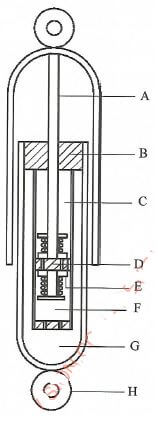
Figure 3- Name the component and the vehicle system in which it belongs.(1 mark)
- State two functions of the component in the vehicle.(2 marks)
- Identify the parts labelled A to H.(4 marks)
- ...............................................
- ...............................................
- ...............................................
- ...............................................
- ...............................................
- ...............................................
- ...............................................
- ...............................................
- Explain how the component works.(8 marks)
-
-
- Draw a labelled circuit diagram of the starting system of an engine.(6 marks)
- Explain how the system in (a) (i) works.(4 marks)
- Outline five possible causes of failure of the starting system.(5 marks)
-
-
- Outline five functions of the vehicle rear axles.(5 marks)
- Explain two disadvantages of the conventional differential unit over the modern unit.(4 marks)
- Draw a differential lock unit and label four parts.(6 marks)
MARKING SCHEME
-
- Power is defined as the capacity or rate of doing work.
-
- Automotive mechanic-Deals with a broad range of both light and heavy vehicle repair work or preparing and maintenance of both light and heavy vehicles.
- Power plant mechanic - Industrial machinery and equipment service and maintenance.
- Automotive parts dealer -Sells vehicle parts, tools and equipment
-
-
- Electric short circuit-Carbon dioxide extinguishers./dry powder
- Firewood -- water in large quantities.
- Flammable liquids - Dry powder extinguisher/CO2
- Combustible materials - FORM extinguisher/ dry powder
-
- British Standard Whitsworth (BSW).
- British Standard Fine (BSF).
- British Association (BA)
- Unified National Screw Thread (UNF, UNC)
- Isometric screw threads.
-
-
- Main reading = 5.00 mm
1/2 readings = 0.50
Thimbles readings (0.01 x 43) = 0.43
TOTAL READING = 5.93 MM -
- - Clutch center plate
- Gearbox synchromesh unit
- Crankshaft timing gear
- Sliding joint of the propeller shaft.
- Gearbox input shaft
- Gearbox output shaft - Areas of application for keys
- Crankshaft pulley
- Alternator pulley
- Generator pulley
- Impeller water pump pulley
- - Clutch center plate
- Main reading = 5.00 mm
-
- Procedure of cutting an internal opening
- Mark out the intended opening,
- Drill a series of small holes close to each other just inside the waste material
- Cut out the opening with a chisel.
- File to the layout line.
-
- Starter motor- converts electrical energy into mechanical energy.
- D.C. generator - converts mechanical energy into electrical energy.
- Procedure of cutting an internal opening
-
-
- Fuel nozzle
- Combustion chamber
- Compressor
- Turbine
-
- Condenser - provides storage for primary current to flow when the contact breaker points are open.
- Spark plug - provides the gap across which the high voltage jumps and creates the spark that ignites the compressed air/fuel mixture.
-
-
- - Direct contact with the crankshaft through gears
- Through chains and sprockets. - Distributor shaft.
Mechanical fuel pump.
- - Direct contact with the crankshaft through gears
-
- The Thermosyphone-Water is drawn in the engine water jackets by gravity and is circulated to the radiator by convection.
Pressurized cooling system - water is circulated by means of a pump. - - It multiplies the engine's available torque by changing drive speed and loads.
- It provides for neutral gear position
- Provides means of reverse
- The Thermosyphone-Water is drawn in the engine water jackets by gravity and is circulated to the radiator by convection.
-
- Reflector - It modifies the light distribution from the primary source and concentrates it in the desired direction.
Lens - Increases side illumination and also re-directs the light rays in a downward direction/focus/concentrates light rays. -
- Soft solders
- Lead
- Tin
- Antimony
- Bismuth
- Hard solders
- Copper
- Silver
- Zinc
- Soft solders
- Reflector - It modifies the light distribution from the primary source and concentrates it in the desired direction.
-
-
- Front brake cylinders
- Air filter
- Anti-freezer
- Air compressor
- Unloader
- Safety valve
- Reservoir
- Rear brake cylinders
- Drain cock
- Pressure gauge
- Brake valve
-
- Flanged axle
- Tappered axle
-
-
-
- Loose stabilizer bar
- Sagging, broken or weak springs
- Deflective shock absorber
- Roof rack overloaded
- Worn out bushes
-
- Kingpin Inclination - This is the angle between the centerline of the upper and lower ball joint and the vertical.
- Included angle - This is the camber angle plus the steering axis inclination angle or K.P.I.
-
-
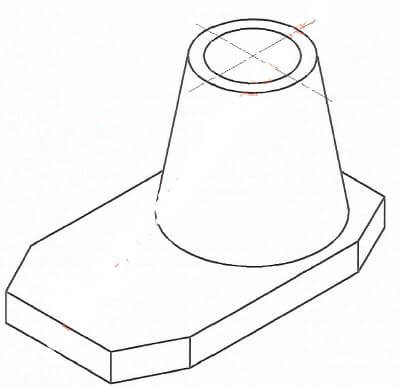
Isometric projection = 1/2 mark
7 faces each @ 1 = 7 mks
3 circular feature each @2 = 6mks
Point A positioned correctly = 1/2 mks
Neatness and linework = 1mk
Total = 15mks -
-
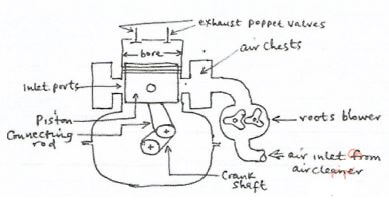
Labelling - 6 parts x 1/2 = 3
Correct sketch -1 = 1
5 main parts 1 = 5 - Operation
- Downward stroke
- When piston moves downwards past the inlet ports, air from the blower is forced through the ports into the cylinder.
- At the same time the exhaust valves opens.
- The fresh charge entering the cylinder forces the burnt waste gases upward and out of the cylinder. - Upward stroke
- As the piston starts to move up, it closes the inlet ports
- The exhaust valve closes and the charge is compressed
- Just before the piston reaches TDC fuel is injected, ignited and burnt hence producing power.
- Downward stroke
-
-
-
- Shock absorber.
Suspension system.
- Shock absorber.
- Dampen spring oscillation/absorbing vibrations
Limit vehicle rolling -
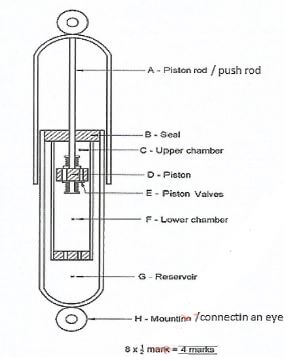
- When the wheel hits a bump/during pump action:
- The wheel is deflected upwards.
- The oil in the lower chamber is compressed.
- The oil pressure in the lower chamber forces the upper valve to open.
- Oil is forced into the upper chamber and since the volume above the piston is less than that below the piston some oil is forced through the calibrated holes in the base valve and into the reservoir.
When the wheel encounters a depression/pot hole/damper shortens/ rebound action: - The wheel is lowered and extends downwards.
- The oil in the upper chamber is compressed.
- The oil pressure in the upper chamber forces the lower valve to open.
- The oil is then forced into the lower chamber hence dampening the oscillations/ leading to the lengthening of the damper.
-
-
-
-
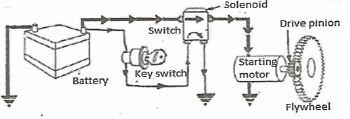
drawing - 3 marks (5 components + earthing)
labelling - 3 marks (6 x 1/2) - Operation
- When the ignition key is tumed to the start position a small current flows from the battery to the ignition switch and through (1) the winding of the solenoid.
- The solenoid is energized (1), and it attracts a plunger which closes the solenoid contact points (1), allowing heavy current to flow to the motor from the battery (1). This is the current that starts the vehicle.
-
-
- Battery in low charge.
- Battery is defective.
- Defective starter solenoid.
- Corroded or loose battery cable.
- Jammed starter.
- Defective starter switch.
- Defective starter engagement/ drive pinion
-
-
-
- Holding the two rear wheels,
- Supporting the weight of the vehicle.
- Transmitting the driving torque to the wheel.
- Transmitting wheel tract on applied back to the vehicle due to the tendency of the wheels to toe-out.
- Absorbing the side thrust during cornering of the vehicle.
-
- Inability to prevent the loss of driving force (1) that occurs when one wheel (1) begins to slip on a slippery surface.
- Lack of further speed reduction and torque increase (1) due to single step down in speed obtained from crown wheel gear and pinion gear set.
-

drawing - (4 marks)
labelling - any 4 x 1/2 = (2 marks)
-
Download KCSE 2018 Power Mechanics Paper 1 with Marking Scheme.
Tap Here to Download for 50/-
Get on WhatsApp for 50/-
Why download?
- ✔ To read offline at any time.
- ✔ To Print at your convenience
- ✔ Share Easily with Friends / Students

